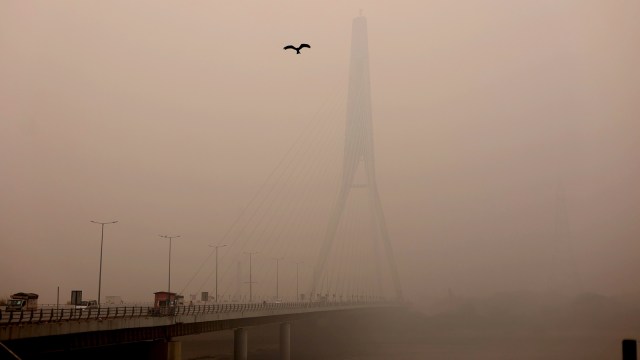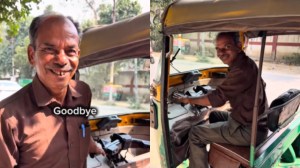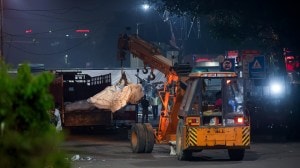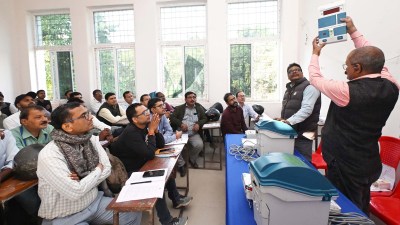Will odd-even scheme kick in in Delhi? Govt to wait and watch
The contribution of the transport sector to PM 2.5 levels in Delhi was 14%, according to the Decision Support System (DSS) of the Indian Institute of Tropical Meteorology
 At 7 am, friday: Siganture Bridge hidden behind a dense layer of smog. (Express Photo by Praveen Khanna)
At 7 am, friday: Siganture Bridge hidden behind a dense layer of smog. (Express Photo by Praveen Khanna) Terming the situation “extremely worrying”, Lieutenant Governor Vinai Kumar Saxena went into a huddle over the capital’s worsening air quality with Environment Minister Gopal Rai on Friday evening.
At a press conference earlier Friday, Rai had sounded an alarm around the spiking pollution levels across north India adding that the coming 15 days were critical in this respect.
Following the meeting, Saxena said several interim measures would be taken including issuing advisories asking children and elderly people to take extra care and remain indoors as far as possible.
An appeal — L-G House officials said in regards to the decisions taken in the meeting — would also be made to people to remain indoors as far as possible, avoid unnecessary travel and if necessary, use public transport, to ensure a lesser volume of traffic and therefore, reduced emissions and dust pollution.
Delhi, officials added, would also appeal to neighbouring states, especially Punjab which accounted for 1921, or 71.57% of the incidents of parali or crop residue burning out of a total of 2684, Haryana which reported 99, Uttar Pradesh 95 and Rajasthan 60 on November 1, to curtail these by incentivizing farmers.
“Pollution levels are increasing across north India, and the next 15 days are critical… In north India – Haryana, UP, Rajasthan, Punjab – governments will have to become active. Those from the BJP are saying that pollution levels are increasing because of Kejriwal. In Ghaziabad and Noida, is pollution increasing because of Kejriwal?” Rai asked at a press conference.
“I would like to request the Union Environment Minister to please be active at least at this time. All of north India is polluted. Haryana’s Environment Minister is quiet. Nobody knows where the UP Environment Minister is. There is a need to take strict measures across the NCR,” he also said.
Asked about stubble burning, Rai said, “In Punjab instances of burning have reduced. Now, the condition is such that the wind and activities close to Delhi and in the NCR are impacting Delhi.”
On whether the odd-even road rationing scheme will kick in, he said: “Everything is being monitored. As things develop, we will take the opinion of experts and act.”
First introduced by the AAP government in 2016 to control vehicular pollution, the scheme is recommended under Stage IV or the ‘severe plus’ category of the Graded Response Action Plan (GRAP), which has not yet kicked in in Delhi. As part of the scheme, private vehicles with registration plates ending in odd numbers could run on odd dates, and even numbers on even dates.
Last year, Stage IV of GRAP was imposed on November 3, when the forecast pointed to the possibility of the AQI entering the ‘severe plus’ category. Measures under GRAP Stage IV were lifted on November 6. After Stage IV was imposed last year, Chief Minister Arvind Kejriwal said that the need for the odd-even scheme was being explored, but it was not implemented.
Some research has shown a drop in particulate matter levels with the odd-even scheme.
According to a study done by Delhi Technological University published in 2016, when the scheme was implemented for a roughly two-week period, concentration of PM 2.5 and PM 1 saw a drop.
As part of measures under GRAP stage-III that were invoked on Thursday, Rai said that mechanical road sweeping machines and water sprinkling machines will now run for 12 hours instead of 8 hours. Mobile anti-smog guns will be deployed in areas where congestion is high.
“Bus services are being increased by 2,400 trips…the metro has increased the number of trips by 60, but metro officials have said that ridership has not increased. I would like to request the people of Delhi to use public transport, so pollution from vehicles can be reduced,” he said.
The contribution of the transport sector to PM 2.5 levels in Delhi was 14%, according to the Decision Support System (DSS) of the Indian Institute of Tropical Meteorology. The contribution of biomass burning was 25.232%, while that from Gautam Buddh Nagar was found to be 4.103%, and that from Sonipat was found to be 4.506%.







